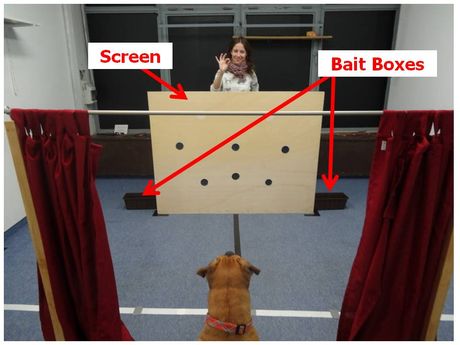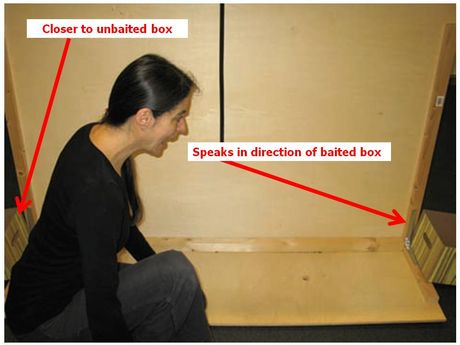Attention
Where You Are Facing When You Speak Is Where Your Dog Goes
Even when they can't see us dogs know the direction we are facing when we speak.
Posted May 13, 2014

Have you ever had the experience of being in a crowd when somebody says "Hey look at that!" or something similar? In such situations you probably found yourself looking in the direction the speaker was facing rather than directly at the speaker. It turns out that even if when we cannot see the person who was talking most people will end up looking in the direction the person was looking at when they spoke out. In other words, we have extracted the location of interest based upon subtle sound cues from speech which gave us an indication of direction. By the time human beings are one year of age they are already able to interpret such vocal cues for direction. This is proved by the fact that toddlers will tend to look or go in the direction that someone is facing when they speak based upon the sound information alone — even if the speaker is not in plain view.
Previous research has shown that dogs and puppies are really good at interpreting human visual cues so that they can find hidden food based only upon a slight glance from a human in the proper direction. It is also well known that dogs pay careful attention to human voice sounds. Since dogs tend to show mental abilities equivalent to a human two-year-old (click here to read about this), it would seem logical to expect that they should also be able to extract information about a location of interest based only on the voice cues that indicate the direction a speaker was facing. Federico Rossano and a team of researchers at the Max Planck Institute for Evolutionary Anthropology in Leipzig, Germany, ran a series of studies to test this*.
Dr. Rossano used basically the same procedure that he had used previously to test human one-year-old kids for this ability. The experimenter is behind a screen. On either side of the screen are two identical boxes. Only one of these boxes is baited with a bit of food (although both boxes contain the food scent).

Next the experimenter ducks down behind the screen out of sight of the dog. She then faces one of the boxes and starts to excitedly say something like "Oh look, look there, this is great!" The question is whether dogs can pick up the vocal hints which show the direction she is facing and use this information to lead them to the correct box. The experimenter is positioned so that she is actually closer to the wrong box, which means that if the dog is just going to the sound of her voice, rather than using information about the direction she is facing, the dog will end up in front of the wrong box.

The results show that dogs do a good job picking up the directional information from the subtle sound cues which indicate the direction that the speaker is facing and they respond to them accurately. This is an important finding since chimpanzees, which are considerably smarter than dogs, do not. As is typical in science, these interesting results raise another question. Could it be that dogs developed the ability to extract direction from voice cues as part of the process of domestication? In other words, did we select dogs which have this ability prewired in their genetic makeup? The alternative is that dogs simply learn this ability as a consequence of living in close association with people.
To try to sort out an answer to this question the research team tested a group of puppies who were only 8 to 14 weeks of age. The idea was that if these young puppies have this ability, it might well be something that is coded in their genes. When they first looked at their results they found that the puppies did, in fact, perform very well, maybe even better than the adult dogs. However all of these puppies had either been living in a household full of humans, or in close association with humans. When they tested a group of puppies which had had considerably less contact with people and had mostly had the companionship of only their littermates, the results were dramatically different. This group performed at a chance level. They seemed to be unable to pick up the information as to which direction the hidden speaker was facing. There are two ways that one can interpret these results. One is that the ability to become skilled at interpreting the directional sound cues which tell you which way a person was facing when they were talking is learned. Given the age of the puppies tested, this skill must be learned very quickly and it must require close association and experience with human beings. The alternate explanation is to suggest that the puppies in the relatively isolated litter were inadequately socialized to people, and therefore did not consider human beings to be sufficiently important to cause them to pay close attention to sound information coming from them. In the absence of close attention to human sounds it is unlikely that their ability to pick up direction from vocal cues, even if it existed in their genetic makeup, would have a chance to kick in.
However the main finding, that dogs can extract directional information from the vocal sounds that humans produce, is important. Research is now making it clear that human beings are very important in the canine mind, and dogs use our gestures, the directions we gaze in, and the sounds that we make to map their environment and to find locations of interest. It also shows that we are continuously communicating information about the world to our dogs, whether we intend to or not.
Stanley Coren is the author of many books including: The Wisdom of Dogs; Do Dogs Dream? Born to Bark; The Modern Dog; Why Do Dogs Have Wet Noses? The Pawprints of History; How Dogs Think; How To Speak Dog; Why We Love the Dogs We Do; What Do Dogs Know? The Intelligence of Dogs; Why Does My Dog Act That Way? Understanding Dogs for Dummies; Sleep Thieves; The Left-hander Syndrome
Copyright SC Psychological Enterprises Ltd. May not be reprinted or reposted without permission
* Data from: Federico Rossano, Marie Nitzschner, and Michael Tomasello (2014). Domestic dogs and puppies can use human voice direction referentially. Proceedings of the Royal Society B. 281; 1785 20133201; doi:10.1098/rspb.2013.3201 (published 7 May 2014).


